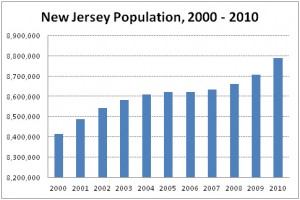New Jersey Future Blog
Census Data Show Population Growth Has Slowed Across New Jersey
December 1st, 2011 by Tim Evans
- Nineteen of New Jersey’s 21 counties gained population in the first decade of the 21st century, according to the 2010 census, with only Cape May and Essex counties losing population. But in 16 of the 19 growing counties, the rate of growth was slower in the 2000s than in the 1990s; the exceptions were Gloucester, Cumberland and Salem.
- Gloucester (13.2 percent) and Ocean (12.8 percent) were the only two counties whose rate of growth in the 2000s exceeded 10 percent. This is quite a contrast with the 1990s, when 11 counties exceeded 10 percent growth, with Somerset topping 20 percent.
- As a group, the eight “urban centers” identified in the State Development and Redevelopment Plan (Newark, Jersey City, Paterson, Elizabeth, Trenton, Camden, New Brunswick and Atlantic City) grew by 1.5 percent between 2000 and 2010. This was actually up from a rate of 1.0 percent between 1990 and 2000.
- Aside from tiny Teterboro (which grew from 18 residents in 2000 to 67 in 2010), the fastest-growing municipality in New Jersey was Woolwich Township in Gloucester County, whose population more than tripled, from just over 3,000 to more than 10,000. In a distant third place was Woolwich’s neighbor, East Greenwich Township, which grew by 76 percent.
Recession Hits Hard, But Urban Areas Show Resilience
Population growth slowed all across New Jersey in the 2000s compared to the 1990s. The state’s total population grew by only 4.5 percent between 2000 and 2010, down from 8.6 percent the previous decade.
In a departure from the pattern of the previous several decades, however, the drop-off in growth has been at least as notable in far-flung exurbs as in cities, as the outward migration from older urban counties to newly developing ones has been curtailed. Exurban Hunterdon County fell from being the third-fastest growing county in the state in the 1990s to ninth place in the 2000s. (In fact, Hunterdon County actually lost population between 2007 and 2010, as did outlying Monmouth, Warren and Sussex counties.)
The urban revival that began in the 1990s was to some degree sustained by this change in migration patterns. The 1990s saw the beginning of a reversal of fortune for many of the state’s urban centers and older suburbs. As a group, the 30 New Jersey cities characterized by the Housing and Community Development Network of New Jersey as the most distressed lost population in each decade from 1950 up to 1990, but gained population in the 1990s. This growth continued into the 2000s, albeit at a reduced rate — 0.9 percent in the 2000s vs. 3.3 percent in the 1990s — and with the caveat that 16 of the 30 lost population over the decade, compared to only 11 in the 1990s. Still, despite the recession having dealt a blow to population growth everywhere in the state, it has generally not sent the cities back onto the downward trajectory from which they had just begun to recover.
The urban revival is such that Hudson, the state’s most heavily urbanized and densely populated county, now has as large a population as it has had in any decennial census since 1950. Hudson reached its peak population in 1930 and then declined every decade all the way through 1990, when it reversed course and began growing again. Its 2010 population is now up to 91.8 percent of its 1930 peak, compared to the low point in 1990, when it was down to only 80.1 percent of its peak. Hudson’s growth in the 2000s was robust enough that it was able to reclaim the position of fourth-largest county by population, a spot from which Monmouth had displaced it in 2000. The success of the “Gold Coast” along the Hudson River waterfront appears to be spreading northward into Bergen County, too; Edgewater and Palisades Park were two of only four municipalities in Bergen County to exceed 15 percent growth over the past decade.
Although Essex County was one of only two New Jersey counties to lose population in the 2000s, the losses did not come from Newark, its largest city. In contrast to the previous five decades, Newark actually gained population between 2000 and 2010. Instead, the biggest losses in the county were sustained by Newark’s urban neighbors — Orange, East Orange and Irvington. This may be a sign that the urban revival may not be extending to inner suburbs, which are beset by some of the same ills that have plagued the cities (crime, deteriorating housing stock) but do not have the cities’ advantages in terms of transit access or commercial tax base.
The relatively good news from the urban front should not, however, be taken to imply that sprawl at the suburban fringe has come to a halt. The stepped-up rate of growth in Gloucester, Salem and Cumberland counties, and the fact that Gloucester and Ocean topped the list of fastest-growing counties in the 2000s, suggest that South Jersey may be the new sprawl frontier. In fact, Woolwich and East Greenwich townships are part of a group of six contiguous municipalities in southwestern Gloucester County that all grew by at least 20 percent over the decade. Of the 50 municipalities statewide that grew by 20 percent or more, seven (or 14 percent of the total) are in Gloucester County.


















Tim–
We met at the Morven affair. I’m doing a detailed traffic profile for the Princeton area necessarily using the 2005-9 ACS for many purposes. Having just read your piece, I went up to the census website to download the NJ municipal 2010 data you cite and find the new FactFinder website quite unfriendly. Where (and how) did you go to pull down the NJ municipal data? Should I look at the 2010 ACS?
Ralph Widner
The new Factfinder is truly awful — very difficult to use, unlike the old system. Repeated complaints to the Census Bureau are ignored. If you want basic population data from the 2010 Census for NJ counties and municipalities, you can find it on the State of NJ’s Department of Labor and Workforce Development website.